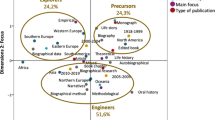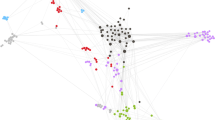Abstract
Individualistic nature of research in the humanities is a common fact, as well as the notion that boundaries in humanities are poorly defined. Using citation analysis we have to take into account differences in citation practices not only between humanities and sciences but also within narrower fields of humanities. In the current study we observe differences between publication behaviour of historians and archaeologists, examine some aspects of citation practices in those fields, and show their effect on visibility.
Similar content being viewed by others
References
Archambault, E., Vignola-Gagne, E., Cote, G., Lariviere, V., & Gingras, Y. (2006). Benchmarking scientific output in the social sciences and humanities: The limits of existing databases. Scientometrics, 68(3), 329–342.
Buchanan, A. L., & Herubel, J. P. V. M. (2011). Journal of Scholarly Publishing, 42(2), 160–181.
Chen, K. (2004). The construction of the Taiwan humanities citation index. Online Information Review, 28(6), 410–419.
Cullars, J. M. (1998). Citation characteristics of English-language monographs in philosophy. Library and Information Science Research, 20(1), 41–68.
Duff, W., Craig, B., & Cherry, J. (2004). Historians’ use of archival sources: Promises and pitfalls of the digital age. The Public Historian, 26(2), 7–22.
European Reference Index for the Humanities (ERIH). Retrieved October 10, 2010 from http://www.esf.org/research-areas/humanities/erih-european-reference-index-for-the-humanities.html.
Garfield, E. (1979). Most-cited authors in the arts and humanities 1977–1978. Current Content, 32, 5–10.
Garfield, E. (1980). Is information retrieval in the arts and humanities inherently different from that in science? The effect that ISI’s citation index for the arts and humanities is expected to have on future scholarship. Library Quarterly, 50(1), 40–57.
Garfield, E. (1982). Arts and humanities journals differ from natural and social sciences journals—but their similarities are surprising. Current Content, 47, 5–11.
Giménez-Toledo, E., & Román-Román, A. (2009). Assessment of humanities and social sciences monographs through their publishers: A review and a study towards a model of evaluation. Research Evaluation, 18(3), 201–213.
Giménez-Toledo, E., Román-Román, A., & Maria Dolores, A.-P. (2007). From experimentation to coordination in the evaluation of Spanish scientific journals in the humanities and social sciences. Research Evaluation, 16(2), 137–148.
Glänzel, W. (2000). Science in scandinavia: A bibliometric approach. Scientometrics, 48(2), 121–150.
Glänzel, W. (2001). National characteristics in international scientific co-authorship. Scientometrics, 51(1), 69–115.
Helm, T. E. (2000). What are you assessing? College Teaching, 48(3), 90–94.
Herubel, J. P. (2007). Musings on disciplinary morphology and nomenclature in the humanities and social sciences: Implications for book selection. Journal of Scholarly Publishing, 39(1), 54–62.
Herubel, J. P. (2008a). Acknowledging Clio’s Lesser children: The importance of journals for historical research and scholarship. Journal of Scholarly Publishing, 39(3), 241–256.
Herubel, J. P. (2008b). Historical scholarship, periodization, themes, and specialization: Implications for research and publication. Journal of Scholarly Publishing, 39(2), 144–155.
Herubel, J. P. (2009). Situating Clio’s influence in humanities and social science monographs. Disciplinary affiliations and historical scholarship. Journal of Scholarly Publishing, 41(1), 56–66.
Herubel, J. P. V. M., & Goedeken, E. A. (2001). Using the arts and humanities citation index to identify a community of interdisciplinary historians: An exploratory bibliometric study. Serials Librarian, 41(1), 85–98.
Hider, P. M. (1996). Three bibliometric analyses of anthropology literature. Behavioral & Social Sciences Librarian, 15(1), 1–17.
Huang, M., & Chang, Y. (2008). Characteristics of research output in social sciences and humanities: From a research evaluation perspective. Journal of the American Society for Information Science and Technology, 59(11), 1819–1828.
Humanities indicators. Retrieved October 10, 2010 from http://www.humanitiesindicators.org/humanitiesData.aspx.
Jones, C., Champman, M., & Woods, P. C. (1972). The characteristics of the literature used by historians. Journal of Librarianship, 4(3), 137–156.
Kousha, K., & Thelwall, M. (2009). Google book search: Citation analysis for social science and the humanities. Journal of the American Society for Information Science and Technology, 60(8), 1537–1549.
Lariviere, V., Gingras, Y., & Archambault, E. (2006). Canadian collaboration networks: A comparative analysis of the natural sciences, social sciences and the humanities. Scientometrics, 68(3), 519–533.
Lewison, G. (2001). Evaluation of books as research outputs in history of medicine. Research Evaluation, 10(2), 89–95.
Linmans, A. J. M. (2010). Why with bibliometrics the humanities does not need to be the weakest link indicators for research evaluation based on citations, library holdings, and productivity measures. Scientometrics, 83, 337–354.
Moed, H. F. (2005). Citation analysis in research evaluation. Dordrecht: Springer.
Moed, H. F., Luwei, M., & Nederhof, A. J. (2002). Towards research performance in the humanities. Library Trends, 50(3), 498–520.
Must, Ü. (1999). Estonian historical science in the 1990s. Research Evaluation, 8(2), 77–82.
Must, Ü. (2011). Alone or together—examples from history research. In Proceedings of the ISSI 2011 conference. 13th International conference of the International Society for Scientometrics and Informetrics,(Vol. 2, pp. 595–604), Durban South Africa, July 4–7 2011, Leiden University and University of Zululand.
Nederhof, A. J. (2006). Bibliometric monitoring of research performance in the social sciences and the humanities: A review. Scientometrics, 66(1), 81–100.
Nederhof, A. J., & Noyons, E. C. M. (1992). International comparison of departments’ research performance in the humanities. Journal of the American Society for Information Science, 43(3), 249–256.
Nederhof, A. J., & Zwaan, R. A. (1991). Quality judgements of journals as indicators of research performance in the humanities and the social and behavioural sciences. Journal of the American Society for Information Science, 42(5), 332–340.
Nederhof, A. J., Zwaan, R. A., De Bruin, R. E., & Dekker, P. J. (1989). Assessing the usefulness of bibliometric indicators for the humanities and the social and behavioural sciences: A comparative study. Scientometrics, 15(5–6), 423–435.
Russian Index for Science Citation (RISC). Retrieved October 10, 2010 from http://eLIBRARY.RU.
Serbian Citation Index. Retrieved October 10, 2010 from http://scindeks.nb.rs/static/about.aspx?lang=en.
Sahiner, M., & Tonta, Y. (2006). Arts and humanities literature: Bibliometric characteristics of contributions by Turkish authors. Journal of the American Society for Information Science and Technology, 57(8), 1011–1022.
Šipka P. (2005). The Serbian citation index: Context and content, In Proceedings of ISSI (pp. 710–711), Stockholm, Sweden, July 24–28 2005, ISSI and Karolinska Univ. Press, Stockholm .
Solow, R. M., Franklin, P., Jones, C. C., D’Arms, J., & Oakley, F. (2002). Making the humanities count: The importance of data. Cambridge: American Academy of Arts & Sciences.
Su, X. N., Han, X. M., & Han, X. N. (2001). Developing the Chinese social science citation index. Online Information Review, 25(6), 365–369.
Su, X.N., Han, X.M., Han, X.N. (2009) Sustainable humanities report from the committee on the national plan for the future of the humanities Amsterdam University Press Commissie National Plan Toekomst Geesteswetenschappen/Amsterdam University Press.
Torres-Salinas, D., & Moed, H. F. (2009). Library catalog analysis as a tool in studies of social sciences and humanities: An exploratory study of published book titles in economics. Journal of Informetrics, 3(1), 9–26.
Webster, B. M. (1998). Polish sociology citation index as an example of usage of national citation indexes in scientometric analysis of social sciences. Journal of Information Science, 24(1), 19–32.
White, H. D., Boell, S. B., Yu, H., Davis, M., Wilson, C. S., & Cole, F. T. H. (2009). Libcitations: A measure for comparative assessment of book publications in the humanities and social sciences. Journal of the American Society for Information Science and Technology, 60(6), 1083–1096.
Winclawska, B. M. (1996). Polish sociology citation index (principles for creation and the first results). Scientometrics, 35(3), 387–391.
Yalcin, H. (2010). Bibliometric profile of journal of national folklore (2007–2009). Milli Folklor, 85, 205–211.
Zhang, L., Rousseau, R., & Glaenzel, W. (2011). Document-type country profiles. Journal of the American Society for Information Science and Technology, 62(7), 1403–1411.
Acknowledgements
An extended version of a paper presented at the 13th International Conference on Scientometrics and Informetrics, Durban (South Africa), 4–7 July 2011 (Must, Ü. Alone or together—examples from history research. Proceedings of the ISSI 2011 Conference. 13th International Conference of the International Society for Scientometrics and Informetrics (Vol. 2, pp. 595–604.), Durban, South Africa, 4–7 July 2011, Leiden University and University of Zululand
Author information
Authors and Affiliations
Corresponding author
Rights and permissions
About this article
Cite this article
Must, Ü. Alone or together: examples from history research. Scientometrics 91, 527–537 (2012). https://doi.org/10.1007/s11192-011-0596-2
Received:
Published:
Issue Date:
DOI: https://doi.org/10.1007/s11192-011-0596-2




